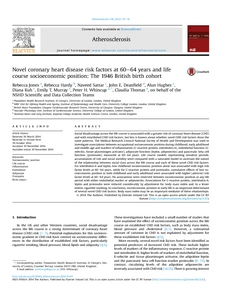Jones, R; Hardy, R; Sattar, N; Deanfield, JE; Hughes, A; Kuh, D; Murray, ET; Whincup, PH; Thomas, C; NSHD Scientific and Data Collection Teams
(2015)
Novel coronary heart disease risk factors at 60-64 years and life course socioeconomic position: The 1946 British birth cohort.
Atherosclerosis, 238 (1).
pp. 70-76.
ISSN 1879-1484
https://doi.org/10.1016/j.atherosclerosis.2014.11.011
SGUL Authors: Thomas, Claudia Whincup, Peter Hynes Jones, Rebecca
![[img]](https://openaccess.sgul.ac.uk/107312/1.hassmallThumbnailVersion/Novel_coronary_heart_disease_risk_factors_60_64.pdf)  Preview |
|
["document_typename_application/pdf; charset=binary" not defined]
Published Version
Download (202kB)
| Preview
|
Abstract
Social disadvantage across the life course is associated with a greater risk of coronary heart disease (CHD) and with established CHD risk factors, but less is known about whether novel CHD risk factors show the same patterns. The Medical Research Council National Survey of Health and Development was used to investigate associations between occupational socioeconomic position during childhood, early adulthood and middle age and markers of inflammation (C-reactive protein, interleukin-6), endothelial function (E-selectin, tissue-plasminogen activator), adipocyte function (leptin, adiponectin) and pancreatic beta cell function (proinsulin) measured at 60-64 years. Life course models representing sensitive periods, accumulation of risk and social mobility were compared with a saturated model to ascertain the nature of the relationship between social class across the life course and each of these novel CHD risk factors. For interleukin-6 and leptin, low childhood socioeconomic position alone was associated with high risk factor levels at 60-64 years, while for C-reactive protein and proinsulin, cumulative effects of low socioeconomic position in both childhood and early adulthood were associated with higher (adverse) risk factor levels at 60-64 years. No associations were observed between socioeconomic position at any life period with either endothelial marker or adiponectin. Associations for C-reactive protein, interleukin-6, leptin and proinsulin were reduced considerably by adjustment for body mass index and, to a lesser extent, cigarette smoking. In conclusion, socioeconomic position in early life is an important determinant of several novel CHD risk factors. Body mass index may be an important mediator of these relationships.
Statistics
Item downloaded times since 30 Jan 2015.
Actions (login required)
 |
Edit Item |



